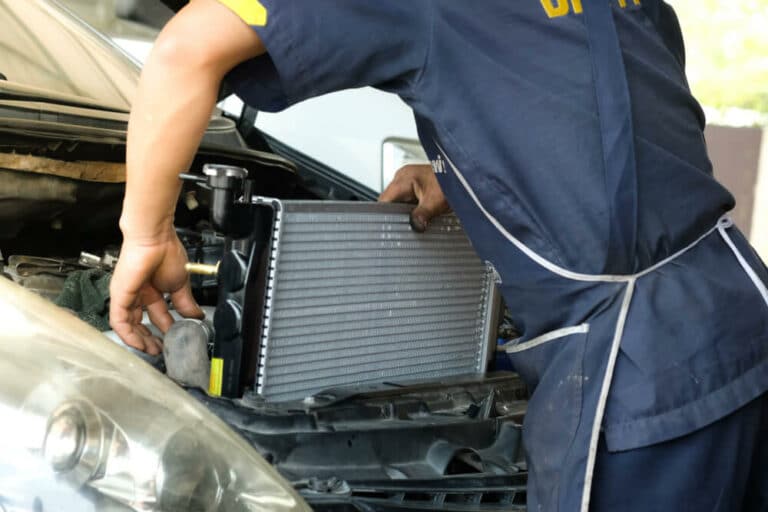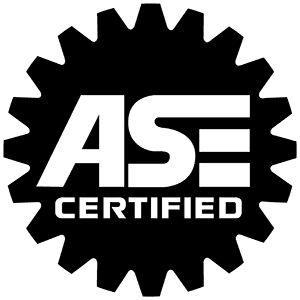Radiator and Cooling System Repair
A radiator is vital to an internal combustion engine’s cooling system. Its purpose is to dissipate the heat generated by the engine during operation.
The radiator is usually made of thin metal fins through which coolant fluid passes.
As hot coolant from the engine enters the radiator, the fins absorb the heat and dissipate it into the air flowing through them.
This causes the coolant to lose heat and cool down before circulating back to the engine block.
The radiator is a heat exchanger that transfers thermal energy from hot coolant to the cooler air outside of the engine.
This temperature drop in the coolant then allows it to absorb more heat when it flows back through the hot engine. A radiator is vital to your engine’s health, so avoid overheating – find a trusted coolant leak repair shop near you today!
What Radiator Issues Lead to Engine Repairs?
Your radiator takes a lot of literal heat. The average radiator lasts between five and ten years. Unfortunately, failure is imminent, and letting a broken cooling system go can lead to engine repairs, fast.
Here’s a closer look at some ways an engine can become damaged if the cooling system fails:
Overheating
Without proper cooling, your engine can rapidly overheat. Excessive heat can cause the cylinder heads to warp, pistons to expand, and engine components like valves and bearings to fail.
While this type of damage seems like it would be gradual, permanent engine damage from overheating can occur between 30 and 60 seconds.
Coolant Leakage
A leak in the cooling system will cause coolant to escape. This reduces the amount available to cool the engine, leading to overheating issues. It can also cause corrosion damage over time as coolant contaminates engine oil and components.
Lubrication Issues
Overheating thickens or breaks down engine oil. This reduces vital lubrication for components like piston rings, bearings, and valve train. Lack of lubrication increases friction and wear, leading to massive engine repairs and premature engine replacement.
Deposits and Sludge
Excessive heat bakes coolant and oil deposits onto engine surfaces. These deposits restrict airflow and act as insulation, reducing the engine’s ability to expel heat.
The bottom line is an engine needs efficient cooling to maintain proper operating temperatures. When the cooling system cannot properly regulate engine heat, the results can range from decreased performance to complete breakdown. Regular maintenance and prompt repair of cooling systems are essential to engine health.
If your engine is experiencing any of these cooling system-related issues, the team at a local Kwik Kar auto repair shop can help. We have garages across DFW, Austin, and Houston, ready to service Texas drivers who need a professional touch to get them back on the road.
Signs of a Failing Cooling System
While your coolant system is vital for regulating engine temperature, things can still get a little too hot, leading to failure and needing a mechanic’s attention.
One of the most obvious signs of a failing cooling system is the engine overheating. As coolant levels get low or components like the water pump or radiator deteriorate, the engine will have difficulty maintaining proper operating temperature. The engine temperature gauge reading high is a clear indicator of overheating.
Another sign is the check engine light coming on. Many engines have coolant temperature sensors that will trigger error codes if temperatures exceed expected parameters.
Coolant leaks are also a major indicator of problems. Drips of coolant under the vehicle likely mean a hose, gasket, or other component has cracked or broken.
Low coolant levels lead to overheating, so leaks should never be ignored.
Finally, if you notice white exhaust fumes, this signals a head gasket leak, allowing coolant to enter the combustion chambers.
Any of these warning signs mean the coolant system needs diagnostic testing and repairs.
The team at a Kwik Kar Auto Services near you can help you catch problems early and prevent expensive repairs down the line.
Radiator & Cooling System FAQs
Is engine and radiator coolant the same thing?
Coolant and antifreeze are often confused as being two different chemicals. However, the truth is, they are the same thing! At the end of the day, coolant is just straight antifreeze mixed with distilled water in a 50/50 blend.
What causes a car to overheat?
– A low coolant level causes the engine to overheat since there is insufficient liquid to carry heat away from the engine.
– A faulty thermostat that doesn’t open to circulate coolant will lead to overheating as heat builds up in the engine.
– Clogged radiators or a damaged cooling fan prevent air from adequately flowing across radiator fins to cool the coolant, resulting in overheating.
– A failed water pump cannot properly pump coolant through the engine, failing to transfer heat away from the engine and leading to overheating issues.
– Leaks, cracks, or blockages in coolant hoses and passages prevent the coolant from fully circulating and cooling the engine.
– Engine issues like seized pistons, bad head gaskets, or excessive friction create excessive heat that typical coolant systems cannot properly dissipate quickly enough.
How do I know if my radiator is broken?
The signs that your radiator has a problem are easy to spot. Some of the most common signs that your radiator is broken can be a constantly overheating engine, leaking coolant, a sweet smell coming from your engine, your heater failing to work, and orange or brown coolant.
Any of these red flags are signs that it’s time to take your radiator in for a check-up at a Kwik Kar near you.
How much does it cost to replace a radiator in a car?
Replacing a radiator for most modern cars costs owners between $400 and $1,000.
What causes too much pressure in the cooling system?
As your cooling system keeps your car cool, water boils and creates steam. Low coolant levels or a stuck radiator cap can lead to steam being trapped and creating too much pressure in your cooling system.
How to clean rust out of the engine cooling system?
Cleaning rust out of your engine cooling system requires several steps:
- Drain the old coolant completely. This will allow you to remove built-up sediment and deposits.
- Use a quality radiator flush chemical to break up rust and corrosion. Let it circulate, then drain.
- If your engine has stubborn rust, you may need to use a descaling agent or metal cleaner. Introduce it to the system and let it soak for a period of time before flushing out. Be sure to use protective gear when handling caustic cleaners.
- If there are severely clogged passages, it’s time to reach out to a Kwik Kar near you to remove components like the radiator or heater core for more access. From there, we can use the tools of our trade to clear out blocked tubes.
- Once flushed, fill the system with distilled water and drain again. This helps rinse out any left over contaminants.
- After you’ve flushed to a desired clean, we recommend adding a coolant system rust inhibitor to help maintain coolant strength and prevent future corrosion.
How to bleed a car radiator?
Adding new coolant to your radiator can lead to air pockets that stop your cooling system from working efficiently.
Bleeding your cooling system keeps your radiator functional. Here are some steps you can take to bleed your radiator once the system has thoroughly cooled:
- Remove the radiator cap
- Put a funnel in your radiator and fill it with coolant
- Start your vehicle, turning the heat on high and the fan on low
- The level of coolant in your radiator will drop. You’ll need to top this off as you monitor your car’s temperature gauge.
- Check that your temperature gauge is within normal range.
- Reinstall your radiator cap and drive the vehicle around.
- Check your coolant levels to ensure stability.

Fix a Leaking Car Radiator
Your car’s radiator keeps the engine running smoothly. If you find that your radiator is functioning a little worse for wear, it’s time to make an appointment with a Kwik Kar near you.
Our full-service auto service centers throughout Texas can help you with everything from extensive radiator problems to quickly oil changes, and tire rotations.
Our services save you time and money, and we even offer Kwik Kar coupons that help you save even more.
When it comes to car cooling systems, trust our ASE certified mechanics to ensure your vehicle receives the best service possible.
Contact us today to schedule an appointment or simply stop in as drive-ups are always welcome.
Additional Auto Repair Services Available at Kwik Kar
If you need more than car radiator repair, we offer more maintenance and repairs at our neighborhood Kwik Kars, including (alphabetical):



